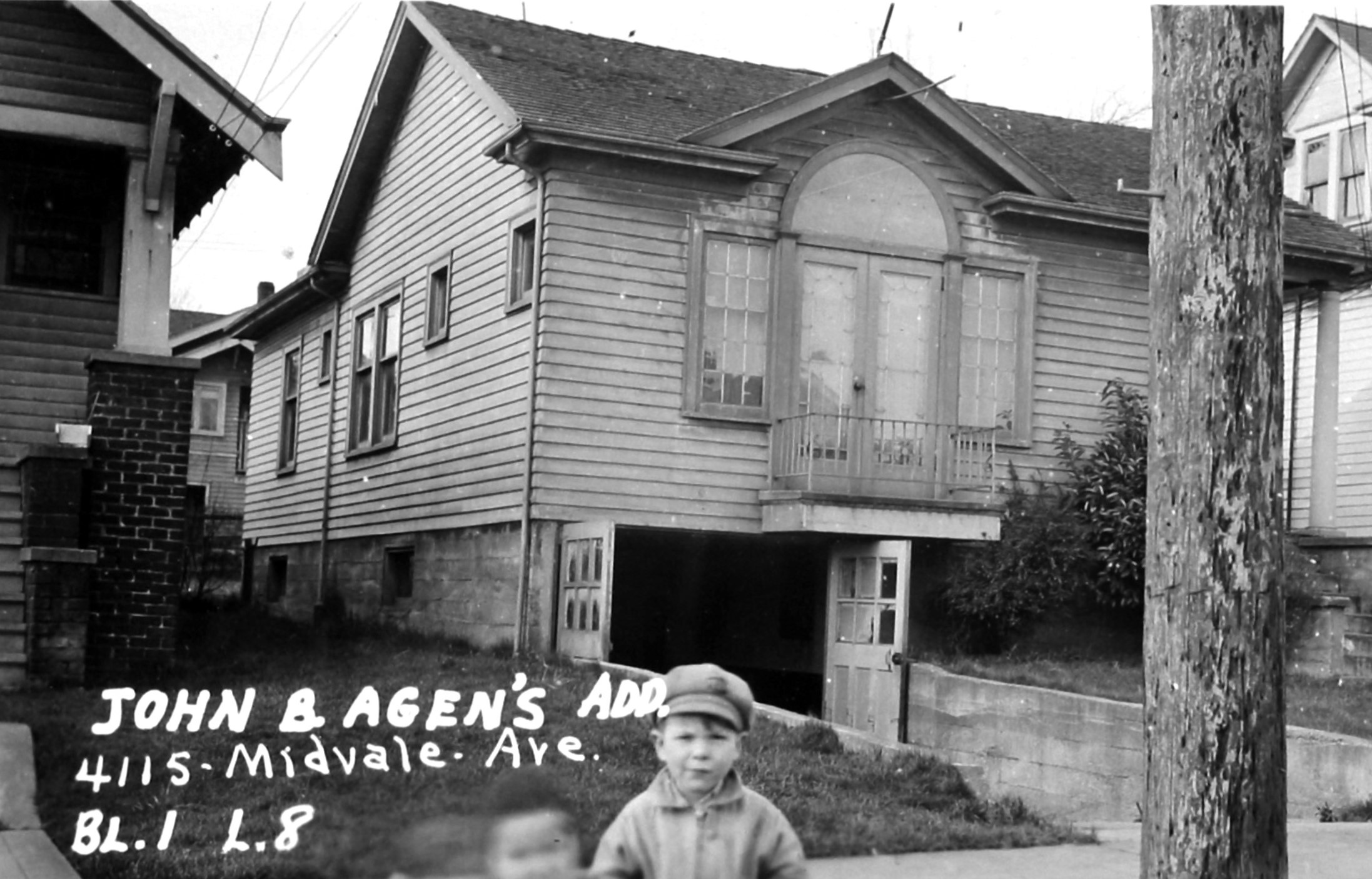In the years 1937 to 1940, King County, Washington, undertook a project to photograph every existing building. As photographers fanned out to neighborhoods, sometimes local children wanted to get in the picture, as in this photo of a house at 4115 Midvale Avenue North in the Fremont neighborhood.
We may speculate that the younger boy in the photo is three-year-old Ronald Cettie, the child of the house in the background, 4115 Midvale Ave N. The other boy might be his neighbor, four-year-old Dale Hyldahl of 4125 Midvale Ave N. Perhaps on this day, Dale sought out a playmate, Ronald, at Ronald’s house.
Perhaps the basement doors which are standing open, are an indication that the boys had been playing there and came out when they saw the photographer. Perhaps Ronald’s Great-Aunt Lena was hanging laundry in the basement and momentarily lost track of the boys. The shadow of death was over this house as Ronald’s mother had died when he was only six months old. Not long after this photo Mr. Cettie, Ronald and Aunt Lena moved to Wallingford. Ronald grew up, attended Lincoln High School and the University of Washington in Seattle. Aunt Lena kept house for Ronald & his father until her death in 1966.
The writing on the photo, “John B. Agen,” is not the name of the homeowner at 4115. It is the legal description of the property with the plat name of John B. Agen’s Addition, Block 1, Lot 8. The plat comprises only two-and-a-half blocks between Woodland Park Ave to Midvale Ave to Stone Way.
John B. Agen was a Seattle businessman who dominated the dairy products industry in Seattle from 1890 to 1916. He did not live in the Fremont neighborhood, but this two-block section of property which was platted into house lots, came to be owned by Agen by way of B.F. Day. B.F. Day was an early resident of Fremont who was a community activist and who donated land for building the present B.F. Day School.
Like many people in Seattle, B.F. Day was badly affected by the economic crash known as the Panic of 1893. In a court case ten years later, Mr. Day was questioned as the whether he was “hiding” any money. He explained that during the 1890s some of the land he had owned, had been transferred into the names of other people so that Day would not lose the property.
One of those people was John B. Agen. Mr. Agen helped B.F. Day financially during the 1890s with the expectation that Agen would recover the money later, when the economy improved, by platting the land into house lots.
John B. Agen had been a successful dairy production businessman in Iowa until, at age 33 in 1889, he decided to see whether he might expand his business to Seattle. He arrived just days after Seattle’s Great Fire of June 6, 1889. At first, because of his network of suppliers and storage in Iowa, he was able to bring products from there to Seattle, until he set up local contacts and networks of dairy farmers.
Agen gained the title of “Father of the Dairy Industry of the Pacific Northwest” for his manufacturing of tinned butter and evaporated milk which was carried by miners to the Klondike Gold Rush of 1897. Agen also established stores in Dawson, Valdez. Nome and Skagway.
Agen went through all the highs and lows of life in Seattle. He was a successful businessman, but experienced the death of his first wife, Catherine, age 30, in 1894. She left behind the Agen’s seven-year-old son, John Stuart Agen. John Agen Sr. remarried in the year 1900, a young woman who, like himself, had Irish immigrant parents. John & Florence Agen had three children together.
Approaching age 60 in 1916, John Agen began selling his businesses and he then lived on income from investments. Agen got pneumonia and died in 1920 at age 64. His widow Florence & her children spent the rest of their lives in Seattle where they were active contributors to the community. John Agen’s eldest son whose mother was Catherine, was well-known in Seattle as a real estate dealer.
Sources:
The life of B.F. Day.
Genealogical & City Directory resources.
HistoryLink Essay #3692, “King County Land Use Survey,” by Paula Becker, 2002.
Wikipedia essay: John B. Agen’s warehouse at 1201 Western Avenue in Seattle.

